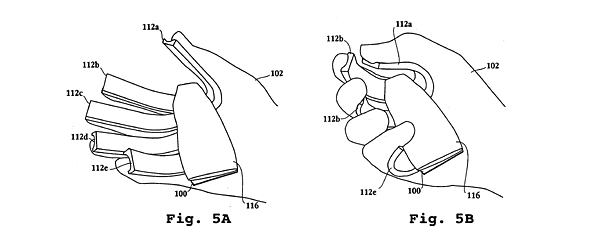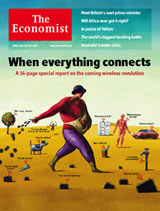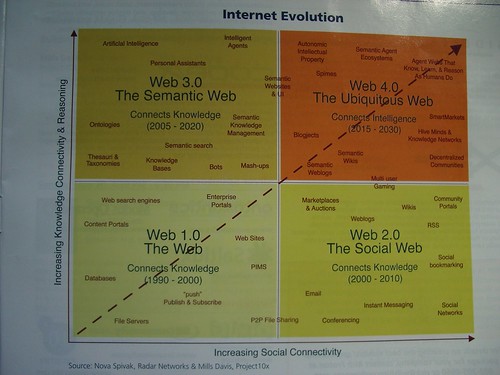It looks like Sony getting on the innovative game controller bandwagon with their hand movement controller, which looks like it's another attempt at creating gestural interfaces. I think that with the popularity of the Wii, a gestural language will develop for controller usage (check out the names for ways to hold your Wiimote in Warioware:Smooth Moves [thanks Mike and Erika!]) and that new controllers will flow out of that, rather than out of core technologies. Still, all-body gestural commands are becoming more popular. Software invocation through movements is coming.
April 2007 Archives
Last Friday there were two surprising (to me, anyway) front page stories about ubicomp. First, the Economist has a special report on "The coming wireless revolution." The end of the first paragraph reads "In coming years wireless will vanish entirely from view, as communications chips are embedded in a host of everyday objects. Such chips, and the networks that link them together, could yet prove to be the most potent wireless of them all."
The next paragraph begins "Just as microprocessors have been built into everything in the past few decades, so wireless communications will become part of objects big and small."
This combination of ideas--wireless, network, microprocessor, everyday objects--is of course the core recipe for ubiquitous computing. Tod and I at ThingM have been working with RFIDs and embedded networking for a while and we think that it's certainly The Future (in terms of augmenting everyday objects). It's going to require deep changes in terms of the design of how people interact with devices and how companies create them.
One company that seems to get it is, again surprisingly, Nintendo. Or at least they got it with the Wiimote, which was featured on the front page of Friday's Wall Street Journal in a story called Magic Wand: How Hackers Make Use Of Their Wii-motes. In it, the WSJ discusses how the open standards of the Wiimote--as Tod pointed out to me, it's a Bluetooth device that uses off-the-shelf components and communication standards--allow people to hack it , including hack it to use Tod's Roomba control software (which is mentioned implicitly in discussing Chris Hughes' hack)> I think that the availability of these communication standards also allowed the company to focus on creating great interaction, rather than on inventing technology. This is the key shift: once there's enough momentum behind a set of standards, technology development shifts from hardware to software, from engineering to interaction design. At the core of these articles is a recognition that wireless technologies have matured enough that we can focus not on how they work, but what they can do for us.
(yes, I'm also amused that the WSJ called the story "Magic Wand")
I'm reading The Design of Things to Come a book that advocates design as a competitive differentiator for companies. It came out in 2005 and the authors are from a (slightly) different world, the world of industrial design and business, but they include a chapter on "Design for Desire," and in that chapter, they spend a lot of time on fantasy. The basic framework is about defining aspirational products as embodiment of fantasies:
Fantasies take place on a personal level, in that individuals create fantasy. A product can support or even engender the fantasy, but the fantasy is that of the individual.[...]
We dream of adventure, of independence, of security, of sensuality, of confidence, and of power. To achieve a sense of adventure, products promote excitement and exploration. To achieve the feeling of independence, products provide freedom [or the illusion of --mk] from constraints. For security, products provide a feeling of safety and stability. [etc.]
[...]
How is fantasy put into a product? What elements of a product induce users to fantasy? Customers expect a product to enhance and fulfill their lifestyle, not simply to perform a function or even to exhibit a desirable aesthetic. When a product fulfills fantasy, it fulfills a desired lifestyle beyond, and in contrast to, the current reality.
This is a fairly traditional, if succinct, definition of aspirational products, and of our projections of our own self-images onto the things we buy. Postrel's Substance of Style delved into it more thoroughly. What's interesting is where they next go with it.
They treat fantasy more literally than the abstract desire to be better in some way as a leading driver of consumption. They start talking about Harry Potter and Lord of the Rings and conclude that "in the fantasy economy, fantasy can be fulfilled in the midst of everyday experiences, for fantasy is just a wish or a desire" and they define good design (as per their book) as "meeting or exceeding the customer's emotional expectation, of form and function fulfilling fantasy."
This chapter is kind of a detour in their argument about design, but it's interesting to see them referencing emotion, fantasy and (implicitly) human irrationality that drives choice. It's a deeply anti-Modernist, anti-functionalist argument, and it's coming from Wharton School Publishing.
I hear Disney is bringing back Tinkerbell as a major character. As a bellweather of design, it's always interesting to see what Disney is thinking. Tinkerbell is one of the least grounded of the Disney pantheon--she only exists because children continue to believe she does--and I wonder if the combination of their desire to revive her, the Wharton folks encouraging the embrace of fantasy, and the popularity of Second Life are all part of a new zeitgeist about detaching from everyday life (through, because this is my filter on the world, technology). Interesting.
I just got a pamphlet inviting me to the 2007 Semantic Technology conference, which has a curious illustration on page 3.
The illustration shows the "evolution" of the Internet, really the Web, since what its creators do is show how "Web 2.0" becomes "Web 4.0." Or something. Basically, I read it as a kind of recasting of classical hard AI opportunistically in the language of modern Web development. You can see that there's an arrow that points to the upper right (connecting, somewhat confusingly, Web 1.0 and Web 4.0, while bypassing Web 2.0 and Web 3.0), which reads "Agent Webs that Know, Learn & Reason as Humans Do."
This is all happening along two primary axes, "Increasing Social Connectivity" and "Increasing Knowledge Connectivity & Reasoning." The first one is clear, it's the primary driver of the flowering of Web 2.0: people are social, so the information they use can be social, too. The second one seems reasonable as a label--yes, we are increasing in the amount of data that's available to us, so we're probably increasing the amount of knowledge. "Reasoning," however, assumes a lot. If you look at the Web 1.0 and Web 2.0 clusters, I don't know if "Enterprise Portals" actually exhibit any appreciably more more "reasoning" than "Databases," as the graph seems to imply.
But this is nitpicking. The interesting thing for me about this graph is how it misses specialized devices almost entirely. "Blogjects" and "Spimes" show up in Web 4.0, yet mobile phones don't show up in Web 1.0/2.0 at all, much less fuzzy logic rice makers. My biases are well known, but if we're to read the projected dates, it appears that "Artificial Intelligence" will show up before ubicomp. I think that's wishful thinking. AI has been 10 years away for 50 years. Devices that employ a limited understanding of semantic relationships between objects in the world are much more likely to appear before reasoning "Intelligent agents" or "bots" and they will look little like top-down models of human cognition. They're going to be like the Roomba, much closer to insects, and behaving as "irrationally" as insects do while functioning much more effectively than systems that try to reason. They will most definitely be part of the evolution of the Internet, too, but it'll be the Internet of things, which will project the Semantic Web into everyday life, rather than leaving it inside some networked abstraction, as I feel this chart implies.








Recent Comments